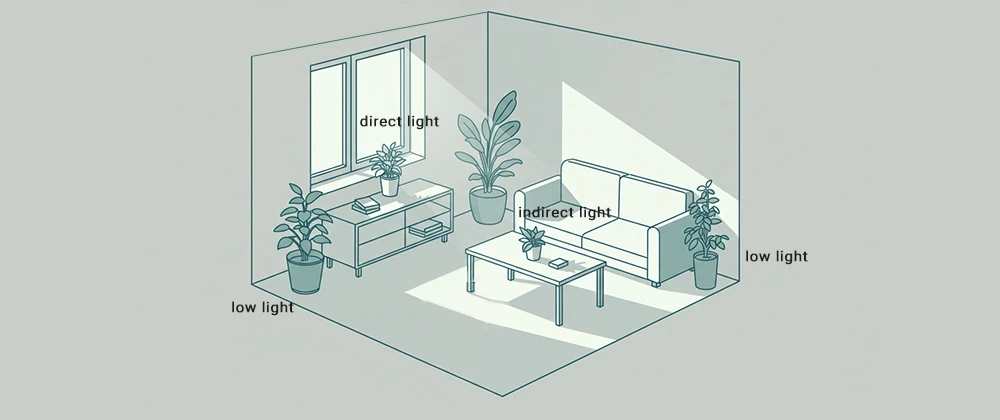What Direct, Indirect, and Low Light Mean for Plants
Light is the main source of energy for plants. It plays a big role in how they grow and stay healthy. But when you’re growing plants indoors, there’s one question that always comes up: “Am I giving my plants enough light? Or maybe too much”
When talking about plant care, you’ll often hear terms like “full light”, “direct light”, or “bright indirect light”. But these words can be confusing. What do they really mean?
Getting it wrong can actually hurt your plants. That’s why today, we’re going to talk about what those common lighting terms really mean: direct light, indirect light, and low light, so you can give your plants what they need.
What is direct light?
Direct light means sunlight that shines straight onto a plant without anything blocking it, like curtains, blinds, or trees outside. This is the kind of light you get when a plant sits right in front of sunny windows with no shade.
Direct light usually comes through south-facing or west-facing windows. A south-facing window gets strong sunlight from morning to early afternoon, often for several hours. A west-facing window gets bright, intense light in the late afternoon and evening.
In terms of brightness, direct light usually measures over 1,000 foot-candles. Plants in direct light typically get at least 5 to 6 hours of sunlight each day.
Plants like succulents and cacti, hibiscus, bird of paradise, and basil require direct sunlight.
What is indirect light?
Indirect light occurs when sunlight is diffused or filtered before it reaches your plants. This can happen when something blocks or softens the light, such as sheer curtains, nearby furniture, or even a tree outside your window.
Indirect light typically comes through north-facing or east-facing windows, where the sunlight is softer and less intense. You may often see plant care tags that say “partial shade” or “full shade”; these terms generally mean the plant prefers indirect light. Even plants placed several feet away from an unshaded window (around 3 feet or more) can still receive indirect light.
In terms of light measurement, indirect light usually falls between 100 to 1,000 foot-candles. When you see the term “bright indirect light”, it refers to the higher end of this range, typically 500 to 1,000 foot-candles.
Plants like Snake plant, ZZ plant, Cast Iron plants, and African Violet grow in indirect light.
What is low light
Low light is actually a type of indirect light, but with much lower intensity. It typically ranges from 25 to 100 foot-candles.
Rooms with no windows or spaces where curtains remain closed most of the time create ideal low-light environments. These areas still receive some ambient light, just not direct sunlight.
Many plants thrive in these conditions. Popular low-light houseplants include lucky bamboo, pothos, ferns, and ivy. These varieties are well-suited to dimmer spaces and can add greenery even in areas where natural light is limited.

FAQ
Is the sun through a window direct sunlight?
Generally, yes, when sunlight shines directly onto a plant through a clear window, it is considered direct sunlight in terms of indoor plant care.
However, if the window glass is frosted or textured, the light becomes diffused and is therefore considered indirect light.
It’s also important to note that standard window glass filters out a significant portion of the light spectrum, blocking 97–99% of UVB rays, 13–40% of UVA rays, and parts of the infrared spectrum. As a result, plants may not receive the full benefit of natural sunlight indoors.
For more accurate and consistent lighting, especially in low-light environments, consider supplementing with LED grow lights designed to provide the full spectrum of light that plants need for healthy growth
Does placing in the shade count as indirect sunlight?
Yes, placing a plant in the shade usually provides indirect sunlight. However, it’s important to remember that not all shade is the same.
For light to be considered indirect, it should still be bright enough to support photosynthesis, just without the intensity and heat of direct sun rays. Deep shade or very dim areas, on the other hand, may not provide enough light for most plants to thrive.
Are LED grow lights direct or indirect light?
LED grow lights don’t fit perfectly into the categories of “direct” or “indirect” natural sunlight, However, they are most comparable to artificial direct light.
This is because most LED grow lights emit focused, directional light that shines directly onto the plant, rather than being diffused or reflected. In this way, they function much like direct sunlight in terms of how plants receive and absorb light.
When using LED grow lights, the key factors to consider are light intensity, light spectrum, and duration. By adjusting these settings, you can simulate the effects of either natural direct or indirect light.

